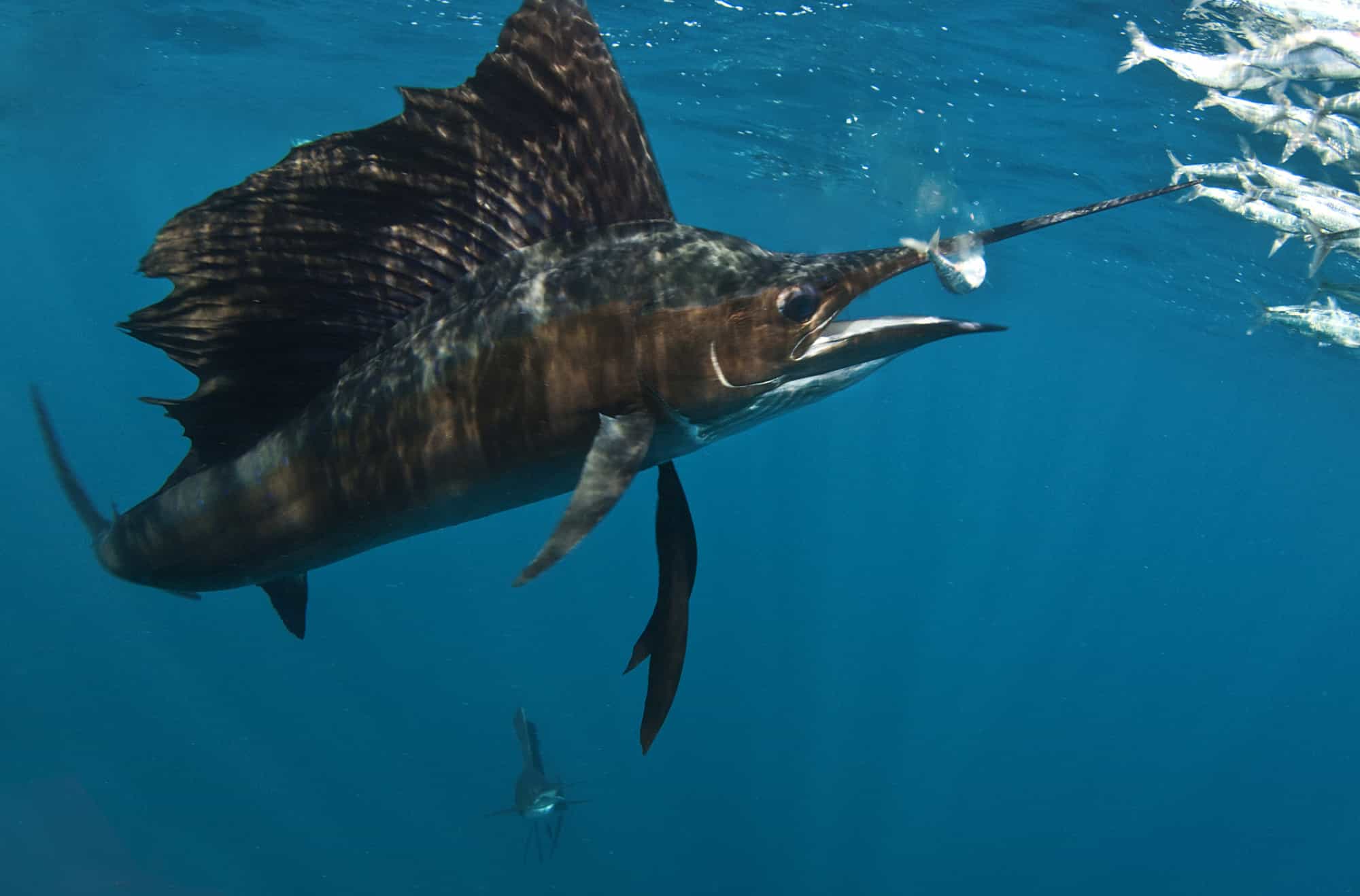With its massive, sail-like dorsal fin and long, spear-like snout, the sailfish has one of the most distinctive and instantly recognizable appearances of any fish species. But the main thing these unique species are notable for is being the fastest fish in the ocean, zipping past other speedy species like sharks and killer whales with ease. So, how fast can sailfish swim, exactly, and what is their top speed? Let’s take a closer look below!
Learn About the Sailfish: Overview and Fun Facts

Sailfish use their long, pointed bills for hunting schools of fish.
©wildestanimal/Shutterstock.com
As you might have already guessed, the sailfish gets its common name from its majestic, sail-like dorsal fin that extends down its head and neck like a crest. This incredible feature isn’t just for looks, either. Sailfish can raise their sails while hunting and retract them while swimming, which helps reduce drag as they move through the water at high speeds.
The other feature sailfish are notable for is their elongated snouts. Their long, pointed bills, although strange-looking, are perfect for whacking and piercing schooling prey fish like sardines. They often work together and hunt in groups. This makes it easier for them to surround schools of fish and secure kills.
In rare cases, sailfish will even attack humans in self-defense. A 73-year-old woman fishing in Florida once reportedly endured a stab to the groin from a 100-pound sailfish when attempting to catch it. Fortunately, the stabbing was not fatal, and the woman recovered after a brief hospital stay. Generally, though, sailfish avoid humans, preferring to stalk schools of small fish.
The taxonomy of the sailfish has been highly debated over the years, though most experts agree either one or two species currently exist. Both varieties are classified under the Istiophorus genus, making sailfish part of the marlin family, Istiophoridae. The main variety most commonly recognized is the Indo-Pacific sailfish, Istiophorus platypterus. However, some sources also recognize an additional species, the Atlantic sailfish, Istiophorus albicans.
Either way, both varieties are similar in size and appearance, and both now have a similar geographic range as well. This has further contributed to the debate over the classification of the one–or two, depending on who you ask–known sailfish species.
How Big Do Sailfish Get?
In addition to being incredibly speedy swimmers (which we’ll cover in more detail below), sailfish grow very quickly. Though they begin their lives as tiny larvae just a few millimeters long, they can reach nearly five feet long within their first year.
At just four to five months old, sailfish are considered mature adults. However, they can continue growing well into their adulthood. Considering sailfish can live for up to 15 years, they have plenty of time to reach pretty impressive sizes. Most wild individuals only live for four to five years, however.
Particularly large adult sailfish can weigh over 90 pounds and reach around seven feet long, though specimens of this size are fairly rare. The largest sailfish ever recorded, according to current IGFA records, was a mind-boggling 220 pounds and 11.2 feet long. The one-of-a-kind specimen was caught by angler Carl Stewart back in 1947. He caught this 220-pound all-tackle record off the coast of Santa Cruz Island, Ecuador.
How Fast Can Sailfish Swim?

In short bursts, sailfish can swim at speeds of up to 68 miles per hour!
©A Cotton Photo/Shutterstock.com
As the fastest animals in the ocean, sailfish have almost no known predators besides the occasional mako shark or killer whale. Studies have varied over the years, but most experts now agree that sailfish can swim at speeds of up to 68 miles per hour in short bursts, usually when hunting prey like schools of smaller fish. When they aren’t seeking out prey, though, they cruise through the water more slowly at speeds that can vary significantly from 15 to 50 miles per hour.
Much of the sailfish’s speed can be attributed to its iconic sail-like dorsal fin! As we covered earlier, sailfish can raise and lower their fin depending on the situation. While they usually raise their fins while hunting to reduce the side-to-side movement of their bills and make them less detectable to prey fish, they keep them pulled low and tight to their bodies while swimming.
This unique ability makes sailfish extremely hydrodynamic and reduces drag while swimming. As a result, their long, narrow bodies can zip through ocean waters at blistering speeds of just under 70 miles per hour!
The photo featured at the top of this post is © A Cotton Photo/Shutterstock.com
Thank you for reading! Have some feedback for us? Contact the AZ Animals editorial team.







